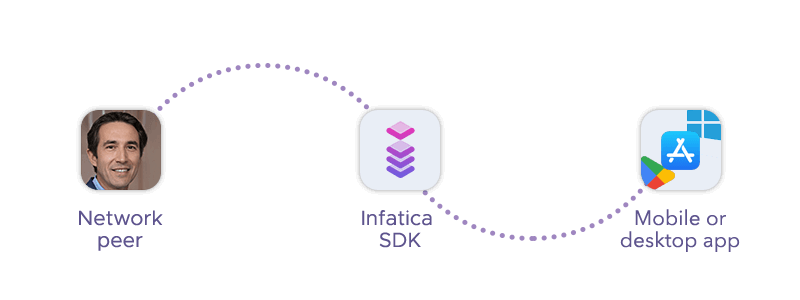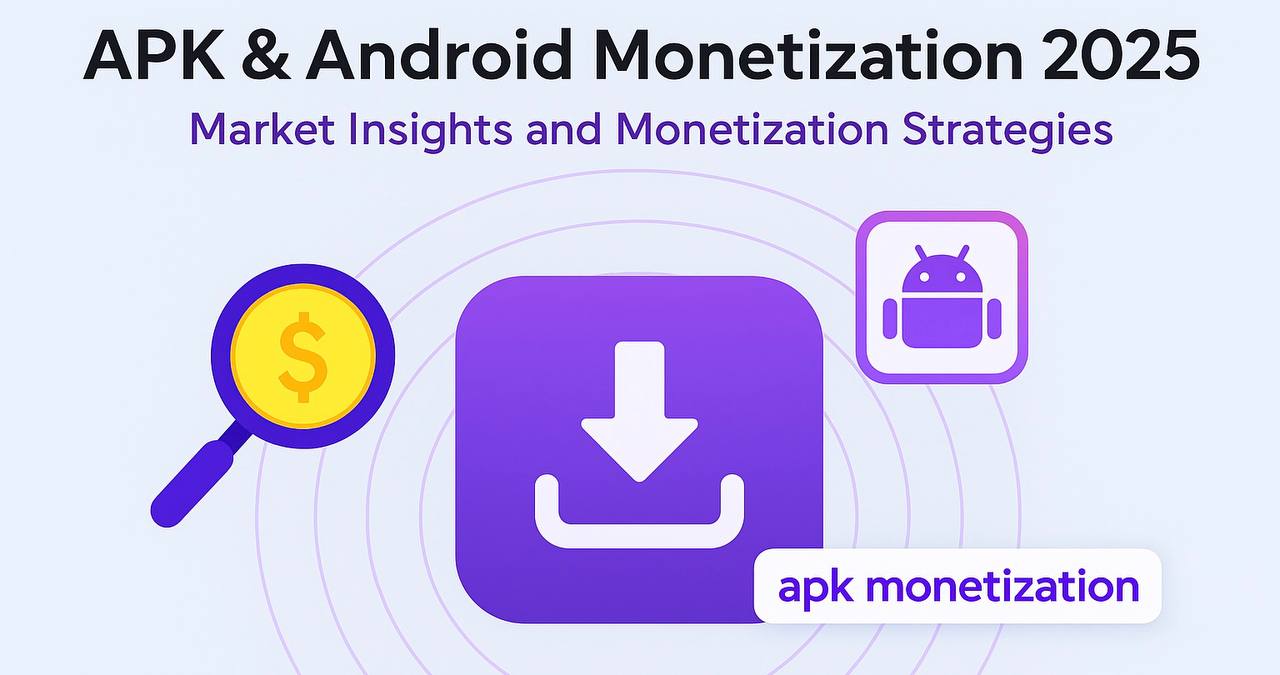In 2025, APK monetization is undergoing a significant transformation due to new privacy laws, policy updates from Google, and shifting user expectations around ads and tracking. As the Digital Markets Act (DMA) reshapes consent policies in Europe and Android’s ecosystem tightens SDK disclosures, developers must pivot toward monetization models that are compliant, unobtrusive, and scalable.
APK monetization is an essential aspect of the mobile app development landscape, but developers are facing new challenges as the industry adapts to stricter regulations and shifting user preferences. The need for more transparent and privacy-friendly monetization solutions has given rise to SDK-based approaches that enable Android app monetization without ads. These models promise a less intrusive user experience and offer scalable solutions for developers aiming to generate sustainable revenue streams.
In this guide, we explore why SDK-based monetization is outperforming traditional ad strategies, how to monetize Android apps without ads, and which monetization tools for developers are most effective today.
Read more about Android App Monetization Trends →
The Changing Monetization Landscape: Key Policy Changes in 2025
- Google Play’s recent ad transparency updates now require detailed SDK declarations in the app’s Data Safety section, giving users more control over their data.
- The Digital Markets Act (DMA) enforcement mandates that EU users receive full control over tracking and monetization consent flows, making it more important for developers to stay compliant.
- Increased scrutiny on passive SDKs used in monetization models is rising, especially those that operate without explicit user consent.
- APK scrutiny is increasing, particularly for apps distributed outside Google Play, such as sideloaded APKs or third-party app stores, which now face more frequent audits.
These regulatory shifts highlight the importance of understanding monetization solutions that not only align with the law but also offer a seamless user experience.
Why SDK-Based Monetization Is Gaining Ground
Traditional monetization models such as interstitial ads, banner ads, and in-app purchases (IAP) are becoming less effective in the current landscape. This is due to factors such as lower click-through rates, user complaints about intrusive ads, and the tightening of platform policies.
Here’s why SDK-based monetization is becoming more popular:
- Non-intrusive passive income: These SDKs operate in the background, allowing you to generate revenue without interrupting the user experience.
- Monetize from all users: Unlike traditional ads, SDK-based models enable monetization from all users, not just those who interact with ads or make purchases.
- Compliance with global privacy laws: SDK-based monetization methods are designed to comply with privacy laws such as GDPR, CCPA, and DMA, helping developers navigate legal frameworks.
- Improved long-term retention: By reducing ad fatigue, SDKs help retain users, resulting in fewer uninstalls.
- Lower dependency on ad networks: SDKs minimize reliance on volatile ad networks or IAP whales, providing a more stable revenue stream.
- Cross-platform compatibility: Many SDKs support both Google Play and independent APK distribution, as well as cross-platform monetization, which is particularly beneficial for developers working across Android, iOS, and desktop applications.
These benefits make SDK-based monetization one of the most effective and scalable solutions for developers in 2025.
Explore 10 Monetization Models →
How Infatica SDK Solves This

Infatica SDK is one of the leading alternative monetization SDKs designed to help developers implement app monetization without ads while staying compliant across global markets.
Key features of Infatica SDK include:
- Generates passive income during every app session, whether active or idle.
- Operates silently, without disrupting UI performance or gameplay quality.
- Supports sideloaded apps, Amazon Store, and Play Store distributions.
- Offers cross-platform monetization for Android, Windows, and iOS, making it an ideal solution for developers working across multiple platforms.
- Eliminates the need for in-app purchases, ads, or user prompts.
- Trusted by developers in over 40 countries, with privacy-first defaults that respect user consent.
- Integrated consent management for transparent monetization workflows, helping developers stay compliant with regulations.
Why APK Distribution Still Matters
In 2025, APK distribution remains an essential monetization strategy, especially in certain regions and circumstances:
- Regions with restricted or censored access to the Play Store (e.g., China, Iran) make APK distribution an attractive alternative for developers.
- OEM partnerships, custom ROMs, and hardware-level preinstalls allow developers to reach users even in markets where the Google Play Store is unavailable.
- Privacy-focused apps that avoid centralized analytics or ad SDKs can benefit from sideloaded APKs.
- Enterprise deployments where Play Store access is disabled also make APK distribution a viable option for developers looking to monetize without traditional app stores.
Compliance Strategy: Avoiding Violations in 2025
To stay ahead of the curve and avoid violations in 2025, developers must adopt effective compliance strategies. These include:
- Disclosing all monetization SDKs in the privacy policy and Play Console.
- Using runtime consent prompts to ensure users are aware of the monetization methods employed within the app.
- Supporting opt-in/opt-out toggles inside app settings to give users control over data sharing.
- Tracking user consent dynamically and storing it securely to stay compliant with legal requirements.
- Mapping SDK data flows to legal bases, such as legitimate interest or consent, to align with GDPR, CCPA, and DMA guidelines.
By implementing these compliance strategies, developers can avoid potential pitfalls and ensure their apps remain in good standing with platform policies and regulations.
Developer Examples & Real-World Adoption
Here are some real-world examples of developers successfully implementing SDK-based monetization:
- A utility app with 1.5M installs saw a 22% uplift in LTV after switching from traditional ads to SDK-based monetization.
- A gaming app that removed interstitial ads restored 19% of its revenue with Infatica SDK alone.
- An education app that distributed as an APK recovered 35% of income after ad restrictions using silent SDKs.
- A file-sharing APK targeting developing countries achieved monetization without any user-facing changes, highlighting the scalability of passive monetization SDKs.
Cross-Platform Potential: Beyond Android
Monetization is no longer limited to Android. Cross-platform monetization is becoming increasingly important as developers seek to expand their reach:
- Microsoft Store monetization for Windows 10/11 desktop apps allows developers to tap into the desktop market.
- Passive monetization on macOS with non-intrusive SDK integration is helping developers reach more users on Apple devices.
- iOS monetization frameworks, designed to comply with Apple’s stringent policies, are enabling developers to create sustainable revenue streams without ads.
SDK-based monetization is also evolving to support cross-platform toolkits, such as Flutter and Electron, making it easier for developers to monetize apps across different platforms seamlessly.
Final Thoughts: Passive Income for 2025 and Beyond
The future of Android monetization lies in non-disruptive, scalable, and regulation-compliant approaches. Passive monetization SDKs like Infatica offer developers a powerful alternative to traditional ads or purchases, with significant advantages such as:
- Monetizing Android apps without showing ads.
- Earning revenue from 100% of users, not just those who convert.
- Respecting user privacy and legal frameworks like GDPR, DMA, and CCPA.
- Deploying across multiple platforms, including desktop and iOS.
- Unlocking monetization without ads even for sideloaded or offline APKs.
→ Start integrating SDK monetization today
Or visit infatica-sdk.io to explore the full documentation.
